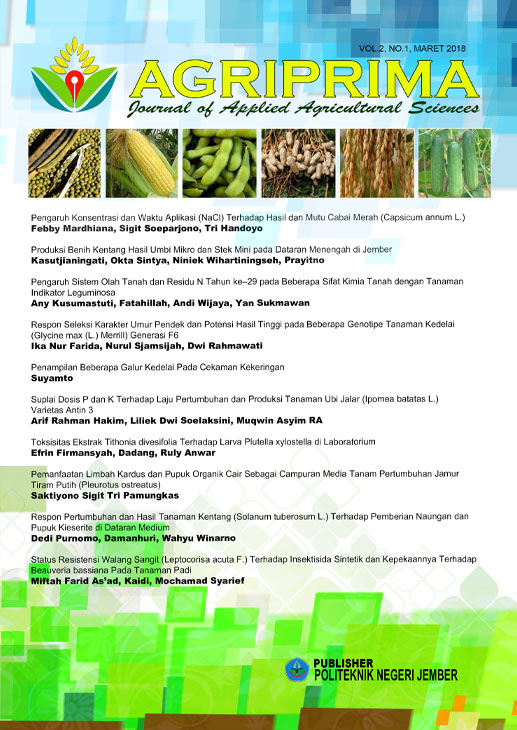Pengaruh Konsentrasi dan Waktu Aplikasi (NaCl) Terhadap Hasil dan Mutu Cabai Merah (Capsicum annum L.)
DOI:
10.25047/agriprima.v2i1.81Downloads
Abstract
Cabai (Capsicum annum L.) merupakan tanaman penting di Indonesia. Dalam 100 gram cabai segar mengandung sekitar 0,1-1,5% capsaicin yang merupakan tingkat kualitas cabai. Salah satu faktor yang mempengaruhi kadar capsaicin adalah kondisi stres salinitas. Kami mengamati efek salinitas dan waktu aplikasi pada hasil dan kandungan capsaisin. Tujuan dari penelitian ini adalah untuk mengetahui respon tanaman cabai dengan penambahan konsentrasi dan waktu aplikasi NaCl terhadap cabai dan kualitas. Penambahan konsentrasi NaCl sampai 9000 ppm dan waktu penerapan fase vegetatif NaCl dapat meningkatkan variabel kualitas kadar capsaicin dibandingkan dengan perlakuan kontrol.
Keywords:
Cabai Capsaicin NaCl Waktu AplikasiReferences
Amirjani, M. R. (2010). Effect of NaCl on Some Physiological Parameters of Rice. Eur J Biol Sci, 3(1), 6–16. PDF
Badan Pusat Statistik. (2016). Jumlah dan Distribusi Penduduk. URL
Chookhampaeng, S., Pattanagul, W., & Theerakulpisut, P. (2008). Effects Of Salinity On Growth, Activity Of Antioxidant Enzymes And Sucrose Content In Tomato (Lycopersicon esculentum Mill.) at The Reproductive Stage. ScienceAsia, 34(1), 069. DOI
Dachlan, A., Kasim, N., & Sari, A. K. (2013). Uji Ketahanan Salinitas Beberapa Varietas Jagung (Zea mays L.) Dengan Menggunakan Agen Seleksi NaCl. Biogenesis, 1(1). DOI
Dittakit. (2014). Increased Nutrient Solution Concentration During Early Fruit Development Stages Enhances Pungency and Phenylalanine Ammonia-lyase Activity in Hot Chili (Capsicum annuum L.). American Journal of Agricultural and Biological Sciences, 9(1), 72–77. DOI
Djukri. (2009). Cekaman Salinitas Terhadap Pertumbuhan Tanaman. In Seminar Nasional Penelitian, Pendidikan dan Penerapan MIPA. Yogyakarta: Fakultas MIPA, Universitas Negeri Yogyakarta. PDF
Fischer, K. S., & Fukai, S. (2003). How Rice Responds To Drought. Breeding Rice For Drought-Prone Environments, 1, 32. URL
Glaz, B., Morris, D. R., & Daroub, S. H. (2004). Periodic Flooding and Water Table Effects on Two Sugarcane Genotypes. Agronomy Journal, 96(3), 832. DOI
Jouyban, Z. (2012). The Effects of Salt Stress on Plant Growth. Technical Journal of Engineering and Applied Sciences, 2(1), 7–10. PDF
Lannes, S. D., Finger, F. L., Schuelter, A. R., & Casali, V. W. D. (2007). Growth and Quality of Brazilian Accessions of Capsicum Chinense Fruits. Scientia Horticulturae, 112(3), 266–270. DOI
Naeimi, M., & Zehtabian, G. (2011). The Review of Saline Water in Desert Management. International Journal of Environmental Science and Development, 2(6), 474. DOI
Rahmawati, H., Sulistyaningsih, E., & Putra, E. T. S. (2013). Pengaruh Kadar NaCl Terhadap Hasil dan Mutu Buah Tomat (Lycopersicum esculentum Mill.). Vegetalika, 1(4), 44–54. DOI
Rosmarkam, A., & Yuwono, N. W. (2002). Ilmu kesuburan tanah. Yogyakarta: Kanisius. URL
Sopandie, D. (2013). Fisiologi Adaptasi Tanaman terhadap Cekaman Abiotik pada Agroekosistem Tropika. Bogor: IPB Press. URL
Sujinah, S., & Jamil, A. (2016). Mekanisme respon tanaman padi terhadap cekaman kekeringan dan varietas toleran. Iptek Tanaman Pangan, 11(1). PDF
Zahra N. Al Hattab, Saadon A. Al-Ajeel, & Ekhlas A. El Kaaby. (2015). Effect of Salinity Stress on Capsicum annuum Callus Growth, Regeneration and Callus Content of Capsaicin, Phenylalanine, Proline and Ascorbic Acid. Journal of Life Sciences, 10(7), 304–310. URL
License
Copyright (c) 2018 Febby Mardhiana, Sigit Soeparjono, Tri Handoyo

This work is licensed under a Creative Commons Attribution-ShareAlike 4.0 International License.
You are free to:
- Share — copy and redistribute the material in any medium or format.
- Adapt — remix, transform, and build upon the material for any purpose, even commercially.
Under the following terms:
- Attribution — You must give appropriate credit, provide a link to the license, and indicate if changes were made. You may do so in any reasonable manner, but not in any way that suggests the licensor endorses you or your use.
- ShareAlike — If you remix, transform, or build upon the material, you must distribute your contributions under the same license as the original.
- No additional restrictions — You may not apply legal terms or technological measures that legally restrict others from doing anything the license permits.









